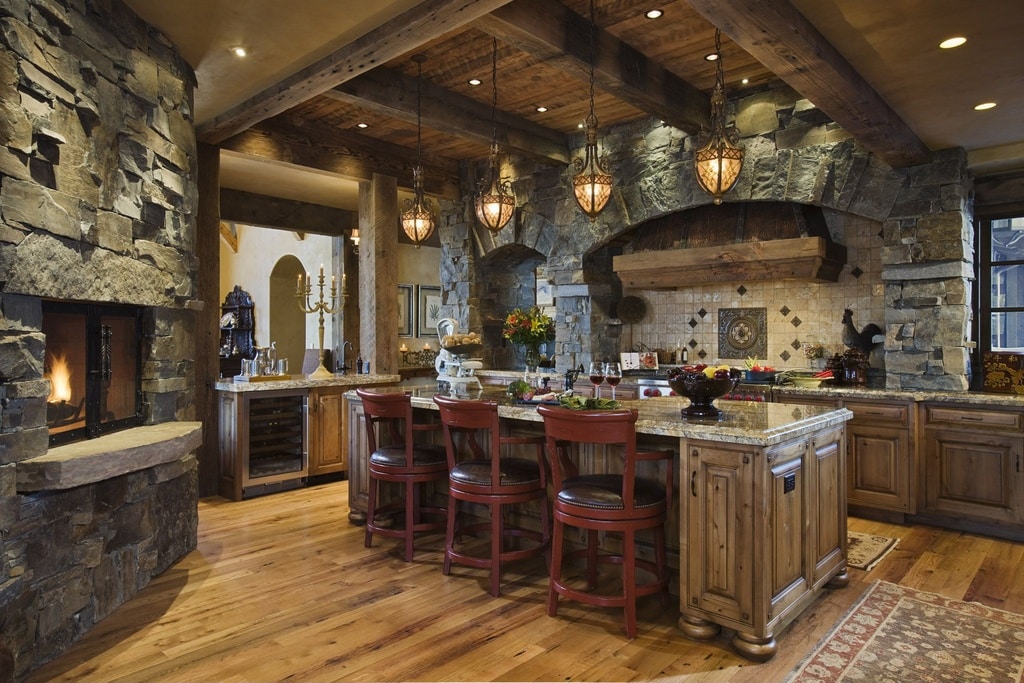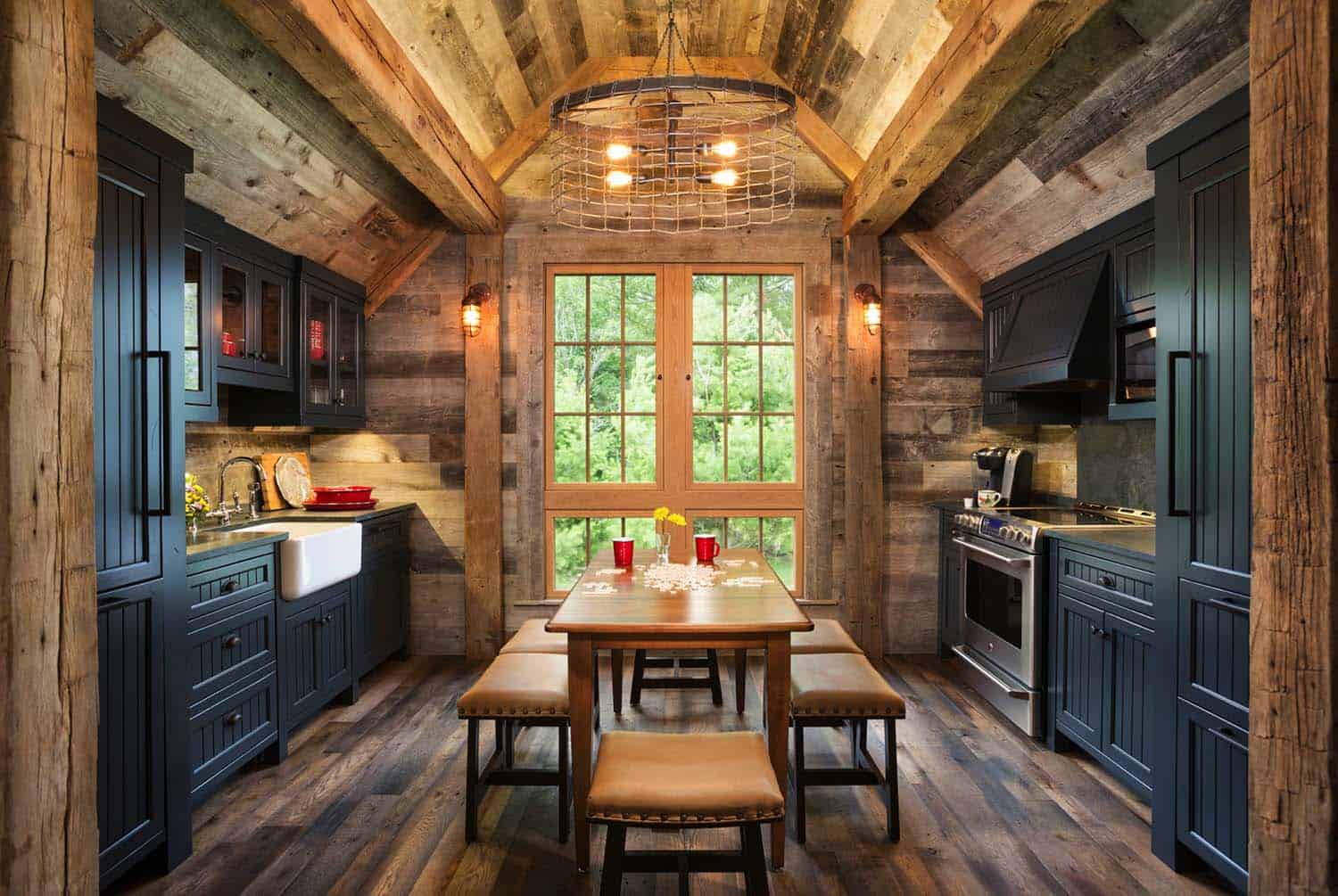A rustic-style kitchen is often used as a general term to describe a certain style, but several components must be in place for a room to qualify for this type of design. Rustic design is often found in cabins and mountainside homes but can be used anywhere, as this style is not limited to location.
Popular for their warm, natural feeling, homeowners who prefer simplicity will be drawn to this type of design. Now done with a modern twist, this type of kitchen is growing in popularity.
What is Rustic-Style Kitchen Design

Rustic design is a style that is raw, earthy, natural, and aged. One of the defining characteristics of this style is the use of natural materials (often in their natural state). It is warm and welcoming. Rustic kitchens are simple and coarse in design.
Often, the design is imperfect and gritty, using natural materials such as raw wood, stone, and metals. Natural flaws such as knots in the wood or uneven grain are highlighted, as opposed to sleek or glossy wood finishes.
The goal is to replicate the simplicity and beauty found outside with an organic aesthetic that creates comfort and warmth. Rustic is referred to as the opposite of modern or contemporary design.
The following elements are common in rustic-style kitchens:
- Warm wood tones
- Wrought iron hardware
- Burnished copper fixtures
- Raw materials
- Organic textures
- Reclaimed materials
- Use of stone
Various rustic design styles and elements can be used to achieve the look. Interior designer Tracy Svendsen, the editor of Canadian Log Homes, says that the trend “leans closely toward rustic utilitarian, with a surge of interest toward clean lines, natural materials, and pared-down décor.
The new rustic provides for a fresh interpretation with the pairing of reclaimed wood and natural elements with existing modern pieces.”
The rustic look can be achieved with the right accessories and finishes. Items should have a hand-crafted look. For example, metal hardware will match exposed wood in the kitchen.
A rustic piece of furniture has a distressed or weathered finish in a color that can be found in nature and has old-fashioned warmth. The details make all the difference.
Rustic Style Kitchen Cabinets

Rustic-style cabinets are simple, without ornamentation. They are usually built from reclaimed lumber or wood from old barns.
The rustic kitchen cabinets can also be manufactured from woods like cedar, hickory, and pine. The wood usually shows imperfections, and the grain is visible. The door style is more traditional.
A traditional Shaker cabinet design will keep the kitchen space simple. For truly rustic and made-from-scratch cabinets, the cabinets may also have hand carvings, or they can remain unpainted and natural.
Rustic Style Kitchen Color Palette

The color palette in this kitchen is calm and neutral. Natural colors like white, beige, brown, and gray are common, but warmer tones are key. Whitewashed walls complement natural wood features and allow the wood to become a focal point.
There are no splashes of bold color in this style. However, rich jewel colors like green and blue work well with rustic design.
A dark red leather kitchen chair complements the neutral palette while adding a layer of warmth. No color scheme is off-limits as long as the colors mimic those found in nature.
Rustic Kitchen Textures

The texture is used throughout the space, with grainy, rough woods and varied natural materials. Rugs made of animal hide or jute, stone fireplaces, and reclaimed wood furniture should be utilized to add texture. Exposed beams add warmth and interest to the kitchen.
Paneling on the wall also adds texture to the room. For a lighter and more modern rustic look, the paneling might be dark, distressed, or whitewashed wood. Walls and floors can be left raw and unpainted.
Handmade pieces with character can also add texture. For instance, curtains or cushions can be handmade, and a patterned rug might also be used.
The local flea market is a great place to find items with textural interest to incorporate into the space. Etsy is another option for unique, handmade items.
Rustic Style Kitchen Countertops

Homeowners have many natural options for countertops. The raw wood edge can be used on countertops, the island, or both. A block of reclaimed wood is not only environmentally friendly but can also be imperfect, which is perfect for a rustic kitchen.
The butcher block style can be used for the regular countertops or the island. The choices of wood include bamboo, black walnut, cherry, maple, and hickory. Other options include natural stone countertops or even granite to break up the use of wood throughout the space.
Rustic Style Kitchen Backsplash

Wood can be used instead of tile for the rustic kitchen. Vertical white wooden slats, mimicking mini shiplap, complement a shaker cabinet. Rough Barnwood is another option. An exposed brick backsplash further highlights the space’s rusticness.
Copper with a patina can be visually interesting for a truly different backsplash. It just needs a coating to waterproof it so the patina does not increase too much.
Rustic Style Kitchen Flooring

Wood or stone are the two most common floor options in a rustic-style kitchen. Wide-planked wood floors are used and are often weathered. Options include cherry, pine, alder, and hickory woods.
After installing and sanding, the staining and preserving can be skipped for a true rustic feel. Using reclaimed wood can help save money on the flooring budget.
On the other hand, using stone gives a more earthy, country feel rather than a modern rustic one. Flagstone flooring is natural and durable but still feels warm and cozy.
Brick is another option for a rustic kitchen floor, but the baked clay can wear. Tile flooring that looks just like bricks will be a more durable option for a kitchen. Either way, installing it in a herringbone pattern is classic yet updated simultaneously.
Rustic Style Kitchen Furniture

Furniture is handmade, heavy, and square. It is often made of weathered or distressed wood, possibly with unfinished edges for a timeworn appearance. It can also be recycled or reclaimed, which reinforces repurposing.
There is usually a mix of materials with the furniture. Bar stools or kitchen chairs might also have a dark, rich leather or suede fabric.
Fabrics like cotton, wool, or linen might also be used. Since this design is simple, the focus is on the natural material, not an elaborate design.
Other natural materials for extra stools or shelving are branches, bark, or twigs. Some homeowners might find this too rustic, so weathered wood is another option. Another way to soften the rawness is to balance it with white elsewhere in the kitchen.
The furniture does not need to be completely rustic. Interior designer Katie Hodges says, “Side tables, accent chairs, and logs are my go-to’s for a dash of rustic without going full-on in that design direction.”
Rustic Kitchen Hardware

Rustic-style kitchen hardware typically uses antique metals. Instead of sleek silver hardware, rubbed brass, wrought iron, or distressed gold or bronze pulls and knobs give the cozy aesthetic. Pewter is a metal that turns silver as it ages, which can also be used.
Mixing cup pulls, and cabinet latches in dark oil-rubbed bronze works well in a rustic kitchen. The oil-rubbed bronze adds to the kitchen’s vintage look and complements the shaker cabinets well.
Rustic Style Kitchen Lighting

Since rustic design is tied to the outdoors, kitchens should have as much natural light as possible. Oversized windows allow for this, and a bay window also works within the rustic design.
Wrought iron or rusted metals can be used for the lighting fixtures. The combination of wood and metal makes for a very rustic design. An iron chandelier with a wood frame is an example of how the two materials can mix well.
Rustic Kitchen Fireplace

Often, rustic-style kitchens have a fireplace reminiscent of older kitchens. A stone fireplace adds another natural material to the space and creates a cozy vibe. Exposed walls around the fireplace bring together the elements of fire, stone, and wood.
Hearth accessories like fire surrounds and baskets can be rugged and increase the use of texture in the space. Texture in the form of woven baskets or rugs near the fireplace makes it feel homey.
Rustic Style Kitchen Sink

A farmhouse-style sink is a must in a rustic kitchen. While these sinks come in various materials, a copper sink that will patina with age will really be a feature. Other material options include soapstone, marble, or black granite.
The sink fixtures should be hand-crafted to match the rusticness. However, they do not need to match the hardware on the cabinets.
Rustic Kitchen Design Appliances

Stainless steel appliances are possible in this type of kitchen. However, the overall theme will still be rustic, as modern-looking appliances will be surrounded by rustic countertops and cabinetry.
Retro-looking appliances will do the job for a less modern appearance. Some manufacturers are making appliances that look like they are from the 1950s but have all of the updated technology.
The Rustic Kitchen Trends
Organic layers are on trend for 2025 in rustic-style kitchens and other styles. Layers of organic materials like raw wood, natural slab counters, and ceramic accents bring outdoor textures indoors. Stone accent backsplashes with a very realistic appearance will bring the outdoors in.
Built-in cabinetry with glass doors that showcase vintage dishes, glassware, and other kitchen necessities is also becoming more popular.
A rustic-style kitchen is warm and inviting, using materials in their natural form. Homeowners should choose kitchen cabinets that reflect this natural design.








